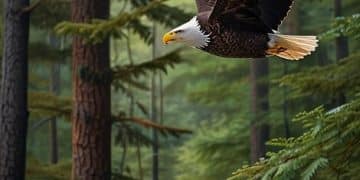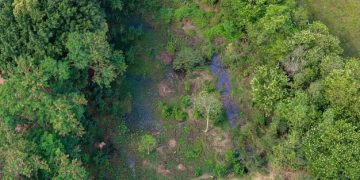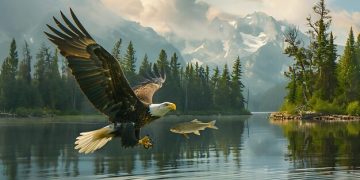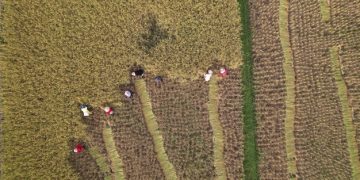Exploring the Financial Impact of Wildlife Tourism on Rural Economies

Wildlife tourism in rural communities significantly boosts local economies by generating revenue, creating jobs, and fostering sustainable development through conservation efforts.
The allure of untamed landscapes and unique wildlife experiences is drawing tourists to rural communities across the US, creating a ripple effect of economic opportunities. Understanding the financial impact: exploring the economic benefits of wildlife tourism in rural communities is crucial for sustainable growth and conservation efforts.
The Rise of Wildlife Tourism in Rural America
Wildlife tourism, a sector driven by the desire to observe animals in their natural habitats, is experiencing a significant upswing, especially in rural communities across the United States. This form of tourism not only offers unique experiences to visitors but also has the power to transform local economies and promote conservation efforts.
In rural areas, where traditional industries may be in decline, wildlife tourism presents a viable alternative for economic growth. It brings in revenue, creates jobs, and fosters a sense of pride in local natural resources. As more travelers seek authentic and sustainable experiences, the demand for wildlife tourism is expected to continue to rise, further boosting the economies of these communities.
Trends Driving Wildlife Tourism Growth
- Increased awareness of conservation issues
- Desire for authentic and immersive travel experiences
- Growing interest in ecotourism and sustainable travel
- Advancements in travel technology and accessibility
Wildlife tourism is a complex and evolving field. Successfully harnessing its potential requires a careful balance between economic development and responsible conservation practices. By understanding the trends and adopting best practices, rural communities can reap the benefits of wildlife tourism while safeguarding their natural heritage for future generations.
Wildlife tourism is not just about watching animals; it’s about fostering a symbiotic relationship between humans and nature that can benefit both. Investing in wildlife tourism is investing in the future of rural communities and the preservation of invaluable natural resources.
Direct Revenue Generation: Dollars from Wildlife Encounters
One of the most immediate and tangible benefits of wildlife tourism is the direct revenue it generates for rural communities. These dollars flow through various channels, creating a significant economic impact.
Entrance fees, tour packages, and permits are primary sources of income. With strategic pricing and effective marketing, these sources can contribute substantially to local coffers.
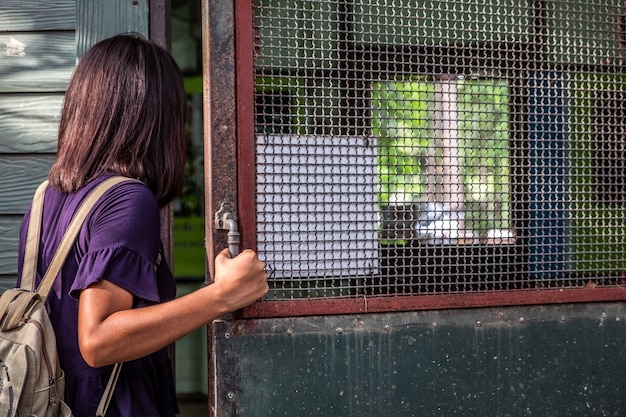
Key Revenue Streams
- Entrance and park fees: Direct revenue from visitors accessing protected areas.
- Tour packages and guided tours: Increased income for local tour operators.
- Permits for specific activities (fishing, hunting, wildlife photography): Revenue linked to regulated activities.
Direct revenue is crucial not only for the sustainability of local economies but also for the long-term conservation of wildlife. A portion of these earnings can be reinvested into habitat preservation, anti-poaching efforts, and community development projects.
Managing revenue streams efficiently requires careful planning and transparency. By ensuring these funds are used wisely, communities can build a stronger, more sustainable future for themselves and the wildlife they cherish.
Job Creation: Employment Opportunities in Rural Areas
Beyond direct revenue, wildlife tourism creates a wide array of job opportunities in rural areas, providing much-needed employment options for local residents. These jobs span various sectors, from hospitality to guiding to conservation.
Wildlife tourism necessitates a workforce that can cater to the needs of visitors and manage the natural resources sustainably. This demand translates into a diverse range of employment opportunities that can help reduce unemployment rates and improve the overall quality of life in rural communities.
Types of Jobs Created
- Tour guides and naturalists: Leading tours and educating visitors about wildlife.
- Hospitality staff (hotel workers, restaurant staff): Providing accommodation and dining services for tourists.
- Park rangers and conservation officers: Protecting wildlife and maintaining park infrastructure.
The creation of these jobs fosters economic independence and encourages local residents to take pride in their natural heritage. By investing in training and education programs, communities can ensure that local people are equipped with the skills necessary to thrive in the wildlife tourism sector.
Job creation in wildlife tourism is not just about providing livelihoods; it’s about empowering communities to become stewards of their own natural resources and build a more sustainable future.
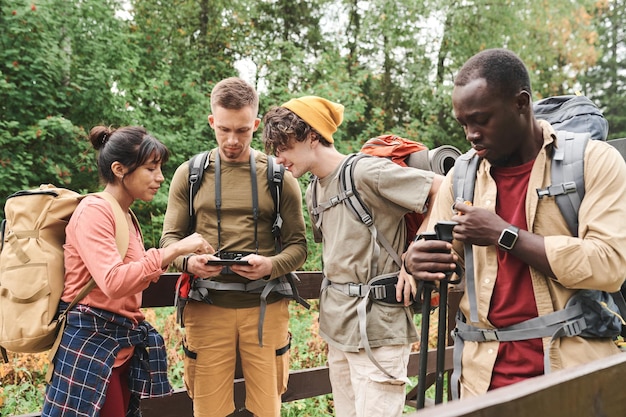
Support for Local Businesses: A Thriving Ecosystem
The economic benefits of wildlife tourism extend beyond direct revenue and job creation. It also plays a vital role in supporting local businesses and creating a thriving economic ecosystem.
As tourism increases, local businesses experience a surge in demand for their goods and services. This increased demand encourages entrepreneurship and investment, further strengthening the local economy.
Impact on Local Businesses
The presence of wildlife tourism can stimulate local economies by increasing the demand for locally sourced goods and services. By prioritizing the involvement of local businesses, wildlife tourism can maximize its economic impact and ensure that the benefits are widely distributed throughout the community.
In sum, supporting local businesses through wildlife tourism is not just about fostering economic growth; it’s about building a resilient and vibrant community that can thrive in harmony with its natural environment.
Local businesses, in turn, become important stakeholders in the success of tourism. They are often strong advocates for conservation and actively participate in the preservation of the destination’s environment and culture.
Conservation Incentives: Protecting Wildlife for Future Generations
One of the most significant benefits of wildlife tourism is its ability to create incentives for the conservation of wildlife and their habitats. When communities recognize the economic value of these resources, they are more likely to invest in their protection.
Wildlife tourism can provide a powerful economic incentive for conservation. By demonstrating that wildlife and their habitats have tangible value, tourism encourages local communities to protect these resources for future generations.
Strategies for Conservation
Communities that benefit economically from wildlife tourism are more likely to support conservation efforts, viewing them as essential for the long-term sustainability of their livelihoods. By linking economic prosperity to conservation, wildlife tourism becomes a powerful tool for preserving biodiversity and protecting natural ecosystems.
Ultimately, conservation linked to wildlife tourism is not just about protecting nature; it’s about ensuring that future generations can experience the wonders of the natural world and reap the economic benefits of a thriving tourism sector.
Protected areas and wildlife sanctuaries that generate revenue from tourism are often better managed and receive greater funding for conservation initiatives.
Infrastructure Development: Investing in the Future
The growth of wildlife tourism often spurs investment in infrastructure development, which can have broader benefits for rural communities. Improved roads, communication networks, and utilities can enhance not only the tourism experience but also the overall quality of life for local residents.
As tourism grows, so does the demand for better infrastructure. Governments and private investors are often more willing to invest in rural areas with a strong tourism sector, leading to improvements that benefit both visitors and residents.
Benefits of Infrastructure Development
- Improved roads and transportation networks
- Enhanced communication networks (internet, mobile coverage)
- Upgraded utilities (water, electricity)
These improvements can lead to increased economic opportunities, improved access to education and healthcare, and a higher standard of living for local residents.
In essence, infrastructure development spurred by wildlife tourism is not just about improving the tourism experience; it’s about building a stronger, more resilient community with a brighter future.
| Key Aspect | Brief Description |
|---|---|
| 💰 Revenue Boost | Increases income through park fees, tours, and permits. |
| 🧑💼 Job Creation | Provides jobs as guides, hospitality staff, and conservation officers. |
| 🌳 Conservation | Creates economic incentives for wildlife and habitat protection. |
| 🛣️ Infrastructure | Spurs investment in roads, communication, and utilities. |
Frequently Asked Questions
▼
Wildlife tourism boosts local economies by generating revenue through entrance fees, tours, and permits, thereby fostering job creation and supporting local businesses.
▼
Wildlife tourism creates jobs in various sectors, including tour guiding, hospitality, park ranging, and conservation, offering diverse employment opportunities.
▼
By demonstrating the economic value of wildlife, tourism incentivizes communities to protect these resources, ensuring long-term sustainability and biodiversity for future generations.
▼
Local businesses benefit from increased demand for their goods and services, fostering entrepreneurship and economic growth within the community, enhancing long run sustainability.
▼
Improvements in roads, communication networks, and utilities enhance the tourism experience and overall quality of life, attracting more visitors and investment to these locations.
Conclusion
In conclusion, the financial impact: exploring the economic benefits of wildlife tourism in rural communities reveals a multitude of opportunities for sustainable growth and conservation. By carefully managing these resources and prioritizing community involvement, rural areas can harness the power of wildlife tourism to create prosperous and resilient economies while safeguarding their natural heritage.
